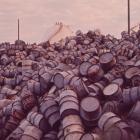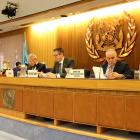Introduction
It is simply no longer possible to look away from polluted landscapes and say, as Americans once did, that toxic trash doesn’t exist, or that it is someone else’s problem, or that it will disappear into the earth.
—Richard S. Newman
Hazardous waste is the dangerous shadow of the industrial age. It is difficult to grasp, both as a phenomenon and as a material substance. Often invisible, it affects people around the globe, yet in unequal ways: hazardous waste poses a risk to human lives and to the ecosystems they inhabit.
Hazardous waste is a twentieth-century phenomenon and a late twentieth-century problem. For as long as “industry” has existed, there has been waste that was harmful to health and the environment. With the chemical-industrial revolution of the 1930s and the age of consumption after the Second World War, this danger rose exponentially. Additionally, the Cold War arms race and concomitant stockpiling of chemical and atomic weapons with an “expiration” date created massive amounts of hazardous waste. Ever-stricter waste management regulation added to the growth of hazardous waste—more materials were identified as dangerous and blacklisted. Many everyday objects, such as batteries, motor oil, or electronic gadgets also turn into hazardous waste and require special care and treatment. Yet, hazardous waste is not easily contained; it often turns out to be more mobile than one would wish—both as a pollutant and a contested commodity. This exhibition will introduce you to the hidden world of the global waste economy. But fear not: there is hope at the end of this waste story!
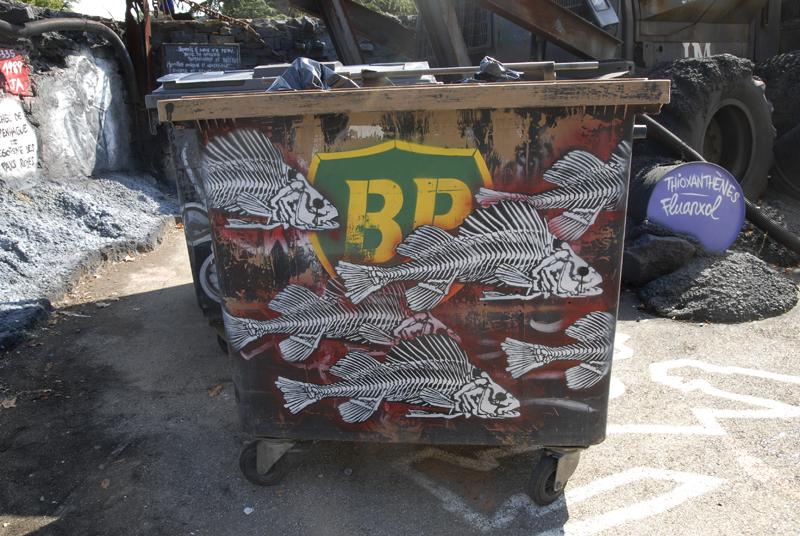
This haunting graffiti on a trash container exhibited close to Lyon, France, protests the ecological catastrophe caused by the oil spill from BP’s Deepwater Horizon in the Gulf of Mexico in 2010. Photograph by Thierry Ehrmann, 2010.
This haunting graffiti on a trash container exhibited close to Lyon, France, protests the ecological catastrophe caused by the oil spill from BP’s Deepwater Horizon in the Gulf of Mexico in 2010. Photograph by Thierry Ehrmann, 2010.
2010 Thierry Ehrmann.
Accessed via Flickr on 13 April 2021. Click here to view source.
 This work is licensed under a Creative Commons Attribution 2.0 Generic License.
This work is licensed under a Creative Commons Attribution 2.0 Generic License.
Every day more hazardous waste material accumulates and moves around on the planet. Citizens and businesses of the European Union, for instance, generated more than 100 million tons of hazardous waste in 2018 alone—that is about 200 kg per person and 11.6% more than in 2010. The numbers are on the rise and threaten not only the waste’s producers, but those beyond the sites of its production. The harmfulness of hazardous wastes does not stop at national borders, and that is why a global perspective offers a more comprehensive picture. Despite decades of discussions, legislators around the globe have yet to agree on a uniform definition of what constitutes hazardous waste. Apart from a shared philosophical understanding of hazardous waste as something which may pose a substantial harm to humans and the environment, countries still differ when it comes to the hard criteria. Around the globe, you find differences concerning thresholds and doses of exposure, materials per se, containment technology, disposal practices, or health and safety standards for sanitation workers. In the past and still today, these changing definitions of hazardous waste create legal and not-so-legal loopholes for waste traders who seize the opportunities generated by those discrepancies. In general, there are certain characteristics that give waste its particularly hazardous character: toxicity, flammability, corrosivity, or high reactivity. Another way of coming to a common understanding is singling out specific components: waste containing PCBs, arsenic, or explosives obviously requires special management to protect people and ecosystems.
All across the world, indigenous communities are at the forefront of combating the climate crisis. In the Amazon region of Ecuador, they have been defending ecosystems against the extractive fossil fuel industry for decades. With their fight against gas flaring, they stand up for the health of people and planet. Film by Theresa Leisgang.
Since the 1970s dealing with, and especially getting rid of such waste, has evolved into a worldwide business. In general, companies usually try to dispose of their hazardous by-products in the most inexpensive manner. This often meant dumping materials on site, disposing of it in a nearby stream, or paying a small fee to local waste haulers to move it somewhere close to their facilities. Facing the conundrum of a growing mountain of hazardous waste, stricter waste disposal regulations, and a growing opposition to waste dumping facilities as of the 1970s, both businesses and municipalities started to look elsewhere to dump their hazardous barrels, sludge, and incinerator ash. Often, elsewhere meant vastly expanding the disposal radius, whether over into the next county, the next federal entity, a neighboring country, or some far away continent. Hazardous waste turned into a dangerous yet lucrative commodity and the world witnessed the emergence of an unregulated waste economy. Most of this multi-million-ton and multi-million-dollar trade took place between OECD-countries. Many shipments, however, also set off under questionable pretexts, destined for countries in the Global South that often lacked the appropriate waste management infrastructure for resource recovery and final disposal. While most of this trade was legal, it thrived on structures of inequality and colonialism both within and between countries, reinforcing racism and classism. IIt is no coincidence that in these unequal trading patterns, a lot of US waste moved to what was for centuries perceived as the country’s “backyards” such as the Caribbean. It is also no coincidence that within the United States, predominantly poor and minority communities have to live in close vicinity to hazardous waste sites.
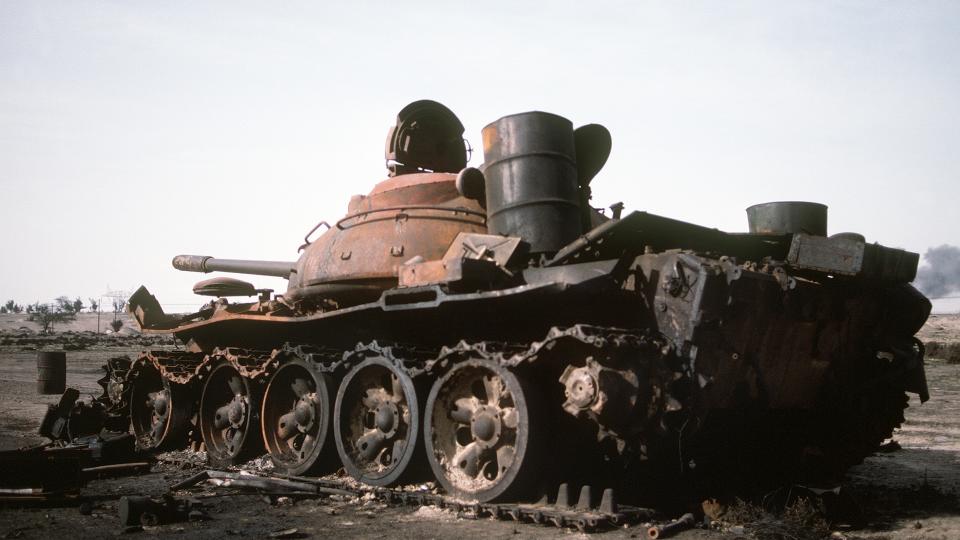
US ammunition equipped with depleted uranium turned bombed out Iraqi tanks into radioactive waste in the 1991 Gulf war. Photograph by Gawlowicz, 1991.
US ammunition equipped with depleted uranium turned bombed out Iraqi tanks into radioactive waste in the 1991 Gulf war. Photograph by Gawlowicz, 1991.
1991 Gawlowicz, US Navy.
Accessed via Wikimedia on 13 April 2021. Click here to view source.
 This work is licensed under a Creative Commons Public Domain Mark 1.0 License.
This work is licensed under a Creative Commons Public Domain Mark 1.0 License.
Ecological disasters and human tragedies linked to hazardous waste have been key turning points for more protective environmental legislation in many countries. The success of enacting stricter regulations in the Global North, however, had a terrible side effect: they sparked the export of hazardous material to other countries where it could be disposed of at a much lower price. When the US Resource Conservation and Recovery Act and the Hazardous and Solid Waste Amendments entered into force in 1980 and 1984 respectively, export numbers rose substantially. In the 1990s, thanks to the concerted effort of activists from all over the world, two crucial UN conventions entered into force to control the global waste trade. This, however, was not the end of the global trade of hazardous waste, as the waste cast its toxic shadow in new forms, such as dubious recycling schemes. As a result, humanity is now facing a condition that we as a research team call the “toxic commons”: the fact that humans, nonhumans, and, in the long run, the Earth system as a whole bear the burden of the intensifying spread of hazardous waste in an increasingly, yet unequally toxified world.
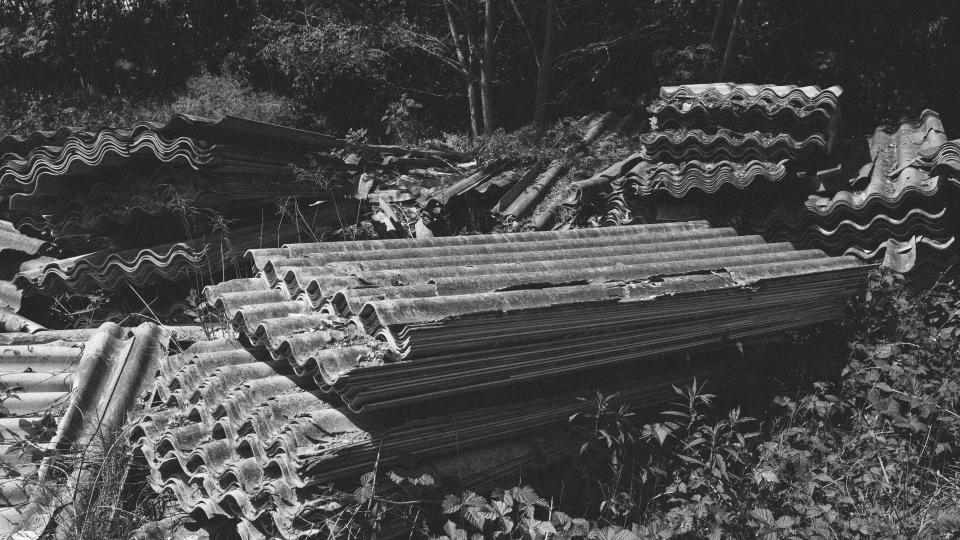
Asbestos roof plates and shingles at an illegal landfill in Fürstenwalde, Germany. Photograph by Jonas Stuck, 2019.
Asbestos roof plates and shingles at an illegal landfill in Fürstenwalde, Germany. Photograph by Jonas Stuck, 2019.
2019 Jonas Stuck.
 This work is licensed under a Creative Commons Attribution-NonCommercial-NoDerivatives 4.0 International License.
This work is licensed under a Creative Commons Attribution-NonCommercial-NoDerivatives 4.0 International License.
Tracking the shady history of the global hazardous waste trade is the aspiration of the authors and curators of this exhibition who together make up the research group Hazardous Travels: Ghost Acres and the Global Waste Economy, financed by the German Research Foundation (DFG). In four individual research projects, the mobility and mutability of hazardous waste came under scrutiny. The group followed the trajectories of the hazardous waste trade, the export of waste objects such as decommissioned ships, “dirty” industries, and the spread of toxins across the Americas, Africa, Asia, and Europe. A mixed-methods approach made the waste itself, as well as human and nonhuman actors, visible throughout the last five decades. Archival research, ethnographic fieldwork, oral histories, and the study of secondary literature informed the research projects. Check out this bibliography with key readings inspiring our research on hazardous waste. This exhibit fundamentally draws from the experiences, encounters, and research decisions of the members of the Hazardous Travels team—including interviews in Hindi, German, Spanish, French, and English as well as treasures from dozens of archives. Of course, these attempts to follow the trails of waste and its connections across continents over several decades necessarily leaves countless blind spots and undetected stories, given that (corporate) archives often remain closed to curious eyes and due to the sheer extent of the hazardous waste problem. In their research designs, the Hazardous Travels members decided not to focus on radioactive waste, as it represents the only kind of hazardous waste that has been well defined, regulated, and has a particular legal trajectory—hence radioactive waste is less mutable than the kinds of waste you will discover in this exhibition. For this exhibition, the authors took a step back from their individual projects to combine and synthesize their insights on the global waste economy.
Dear exhibition visitor, you are now invited to explore the rooms (or chapters) of this virtual exhibition in any order you like and dwell there as long as you wish. But before you do so, take a short break from reading and enjoy this brief narrated story of the global waste economy as a mini-podcast:
The original exhibition includes a podcast on the intriguing history of the global waste economy in 3 minutes. © 2019 DFG Hazardous Travelsresearch group and Ruhi Deol. Listen to the podcast here: http://www.environmentandsociety.org/exhibitions/toxic-relationships/introduction.
Listen to the intriguing history of the global waste economy in 3 minutes. © 2019 DFG Hazardous Travels research group and Ruhi Deol.
- Previous chapter
- Next chapter








